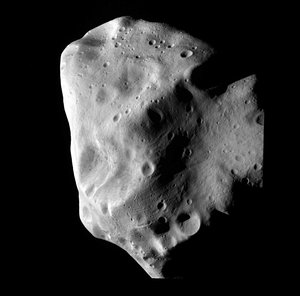NEOMIR: finding risky asteroids outshone by the Sun
Asteroids, like stars, only come out at night. Hidden in the glare of our Sun are an unknown number of asteroids on paths we cannot track, many of which could be heading for Earth, and we just don’t know it.
ESA’s planned NEOMIR mission will be located between Earth and the Sun and will act as an early warning system for asteroids 20 metres and larger that cannot be seen from the ground.
Predicting Chelyabinsk
No one saw the Chelyabinsk meteor of 15 February 2013 coming. Just after sunrise on a calm and sunny winter’s day, a 20-metre asteroid struck the atmosphere over the Ural Mountains in Russia, at a speed of more than 18 km/s.

The relatively small rock approached Earth from very near the direction of the Sun, exploding in the atmosphere and creating a shockwave that damaged thousands of buildings, breaking windows and injuring roughly 1500 people from flying shards of glass. It was the largest asteroid to strike Earth in over a century.
Statistically, asteroids this size strike Earth about once every 50-100 years. Larger asteroids are far less common but – just ask the dinosaurs – do a great deal more damage. These are, fortunately, much easier to detect.

In fact, we have discovered almost all asteroids larger than 1 km in size. Small and medium-sized asteroids are more common, and can still do great damage, but warning times of a few days can be enough for local authorities to notify the public to keep away from windows or even to evacuate a local area.
With NEOMIR, we’ll be prepared
Whether it’s preparing for a mission to deflect a large asteroid years in advance or providing the data for local authorities to keep communities informed of airbursts weeks ahead, ESA’s NEOMIR will fill a gap in our current asteroid detection capabilities.
![Lagrange points are locations in space where the gravitational pull from the Earth equals the pull from the Sun, and satellites can reside with less ‘orbital mainentence’ than those orbiting Earth or flying out to deep space.]](/var/esa/storage/images/esa_multimedia/images/2004/11/spacecraft_in_sync_with_earth_orbit/9843675-4-eng-GB/Spacecraft_in_sync_with_Earth_orbit_article.jpg)
Asteroids are visible because they reflect the Sun’s light, which we can detect from Earth. However, the closer they get to the Sun, the harder they are to see. Asteroids crossing the face of the Sun are particularly difficult to detect, but from Earth we are also blind to asteroids near the Sun as they are outshone by its glare.
ESA’s upcoming NEOMIR mission will be launched into orbit around the first Lagrange point (L1) between the Sun and Earth, remaining in the same position relative to the two bodies. This will give the telescope a view of asteroids that may come towards the Earth from the direction of the Sun.

Being situated outside of Earth’s distorting atmosphere and with a telescope observing in infrared light, NEOMIR will monitor a close ring around the Sun that is impossible to observe from the ground. The mission will detect asteroids passing between Earth and the Sun – any that pose a threat and that we cannot currently see will have to pass through this ring.

By making observations in the infrared part of the light spectrum, NEOMIR will detect the heat emitted by asteroids themselves, which isn’t drowned out by sunlight. This thermal emission is absorbed by Earth's atmosphere, but from space NEOMIR will be able to see closer to the Sun than we can currently from Earth.
Asteroids 20 metres and larger that are heading toward Earth should be detected by NEOMIR at least three weeks in advance. In the worst-case scenario, in which the asteroid is spotted passing near the spacecraft, we would get a minimum of three days’ warning – the fastest the asteroid could move from L1 to Earth.
Current status

Details of the Space Safety Programme's NEOMIR mission are currently being fleshed out and it is planned to be launched around 2030 with an Ariane 6-2 rocket.
An initial study to assess the feasibility of the NEOMIR mission was conducted by ESA's Concurrent Design Facility in the Netherlands, in 2021. The study focused on defining a mission that would complement NASA's NEO Surveyor mission. The US-funded mission should fulfil the US Congress mandate to discover 90% of near-Earth objects larger than 140-metres in diameter, while NEOMIR is designed to focus on imminent impactors of any size.
NEOMIR is currently early mission study phase. It will require a half-metre telescope with a large, corrected focal plane, as well as two infrared channels covering light in the 5-10 micrometre waveband.

The required detector technologies and associated electronics for this novel mission are currently under development. Industrial research and development projects are planned as supporting activities in parallel.
The requirements will be to deliver a similar performance to the ‘NEO Surveyor detectors’, i.e., Teledyne's HxRG, which are in use in the James Webb Space Telescope (NIRSpec) and ESA’s Euclid (NISP) and Ariel missions, although at shorter wavelengths.















 Germany
Germany
 Austria
Austria
 Belgium
Belgium
 Denmark
Denmark
 Spain
Spain
 Estonia
Estonia
 Finland
Finland
 France
France
 Greece
Greece
 Hungary
Hungary
 Ireland
Ireland
 Italy
Italy
 Luxembourg
Luxembourg
 Norway
Norway
 The Netherlands
The Netherlands
 Poland
Poland
 Portugal
Portugal
 Czechia
Czechia
 Romania
Romania
 United Kingdom
United Kingdom
 Slovenia
Slovenia
 Sweden
Sweden
 Switzerland
Switzerland


































